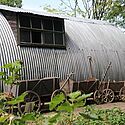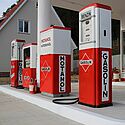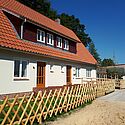Häuser und Baugruppen im Freilichtmuseum am Kiekeberg
Die Museumslandschaft des Freilichtmuseums am Kiekeberg besteht aus mehreren Baugruppen, welche Architektur und Lebensweisen unterschiedlicher Gebiete und Zeiträume vom 17. Jahrhundert bis in die Nachkriegszeit darstellen.
The heath village
The rural economy of the Nordheide heath region was characterised by poor soil which was only suitable for a small number of crops. In addition to this, the farms were very widely dispersed, with markets a long journey away. Livestock was primarily used to provide food for the population and to produce fertilisers. Rye, oats, buckwheat and, from the mid-1800's, also potatoes were cultivated. The wattle and daub walls used for the buildings are a reflection of the impoverished conditions. The Silberhof and Corbelinscher Hof farmhouses are exceptions to this. The heath village has a total of 17 buildings.
![[Translate to Englisch:] Der Pringenshof aus Kakensdorf im Freilichtmuseum amKiekeberg (Bild FLMK) Der Pringenshof aus Kakensdorf im Freilichtmuseum amKiekeberg (Bild FLMK)](/fileadmin/_processed_/2/8/csm_Fruehling_am_Kiekeberg_Foto_FLMK__15_800_6efd76e634.jpg)
![[Translate to Englisch:] Historische Kochstelle um 1800 im Freilichtmuseum am Kiekeberg (Bild FLMK) Historische Kochstelle um 1800 im Freilichtmuseum am Kiekeberg (Bild FLMK)](/fileadmin/_processed_/2/2/csm_Pringens_Hof_-_Bild_FLMK__2_800_f5d7da8edb.jpg)
![[Translate to Englisch:] Die Dragonerscheune von 1700 am Kiekeberg (Bild FLMK) Die Dragonerscheune von 1700 am Kiekeberg (Bild FLMK)](/fileadmin/_processed_/4/2/csm_Sommer_im_Freilichtmuseum_am_Kiekeberg_-_Foto_FLMK__2_800_9c87abfd52.jpg)
The marsh village
The fertile Winsen Marsh area extends along the banks of the Elbe river. Its fertile soil is used to grow grain and vegetables. High yields and the close proximity of Hamburg, a market which could be reached easily, meant that cattle and horse breeding were also profitable activities. In addition to this, the Elbe provided a livelihood for many families, who made their living from shipping, commerce, fishing and basket weaving. The marsh village is made up of ten buildings. It also includes the building at the museum's entrance, the Wagner house from Oldershousen (built in 1803).
![[Translate to Englisch:] Handwerker- und Fischerhaus aus Drage (1703) im Freilichtmuseum am Kiekeberg (Bild FLMK) Handwerker- und Fischerhaus aus Drage (1703) im Freilichtmuseum am Kiekeberg (Bild FLMK)](/fileadmin/_processed_/c/d/csm_Gebaeude_im_Freilichtmuseum_am_Kiekeberg_-_Fischerhaus_-_Bild_FLMK__2_800_f0237dcb3d.jpg)
![[Translate to Englisch:] Eingangsbereich Hof Meyn aus Marschacht (erbaut 1560) (Bild FLMK) Eingangsbereich Hof Meyn aus Marschacht (erbaut 1560) (Bild FLMK)](/fileadmin/_processed_/d/0/csm_Hof_Meyn_im_Freilichtmuseum_am_Kiekeberg_-_Bild_FLMK800_74c043d6cd.jpg)
The rural industrial revolution
Mechanisation in rural Germany began around 1850 with the first industrial businesses coming into being. They included dairies, brickyards and, with the introduction of cement, also works which made concrete blocks. Modern steam technology also allowed rural distilleries to produce larger quantities of spirits. In addition to this, the population in the countryside began to use more tools and equipment which made their everyday lives less arduous. Horse and animal engines, for example, were used to drive threshing or straw-cutting machines. We have six buildings dating from the industrial revolution which are located all around the grounds.
![[Translate to Englisch:] Rekonstruiertes Betonfertigteilewerk aus Oeldorf von 1900 am Kiekeberg (Bild FLMK) Rekonstruiertes Betonfertigteilewerk aus Oeldorf von 1900 am Kiekeberg (Bild FLMK)](/fileadmin/_processed_/4/4/csm_Betonfertigteilewerk_-_Haus_10_-_Bild_FLMK800_32252b2cf5.jpg)
![[Translate to Englisch:] Hühnerstall aus Winsen (Rekonstruktion) um 1900 am Kiekeberg (Bild FLMK) Hühnerstall aus Winsen (Rekonstruktion) um 1900 am Kiekeberg (Bild FLMK)](/fileadmin/_processed_/4/b/csm_Das_Freilichtmuseum_am_Kiekeberg_im_Herbst_-_Huehnerstall_aus_Winsen__erbaut_um_1910_-_Bild_FLMK__1_800_2e6eb1324c.jpg)
![[Translate to Englisch:] Winterlandschaft mit Göpelschauer, Kartoffelspeicher und Windrad am Kiekeberg (Bild FLMK) Winterlandschaft mit Göpelschauer, Kartoffelspeicher und Windrad am Kiekeberg (Bild FLMK)](/fileadmin/_processed_/8/d/csm_In_winterliches_Licht_getaucht_-_historische_Gebaeude_im_Freilichtmuseum_am_Kiekeberg_-_Kartoffelspeicher_-_Bild_FLMK800_19d9e67dfc.jpg)
The Königsberger Straße
The „Königsberger Straße“ is under construction. Five buildings from the postwar period to the end of the 1970s will be shown here. All proper furnished and with gardens of that time. Some buidlings are already opened: The 1950s gas station from Stade and two semi-detached houses with an integrated exhibition on the region's history after 1945. The opening of the whole street is planned for 2023.



The Agrarium
The Agrarium has been part of the museum since 2012. The exhibition, which covers 3 000 m² on three floors, presents developments in agriculture and food production - in the past, today and in the future. In addition to this, we have a further 300 m² under an outdoor pitched roof which are home to our collection of agricultural machines. They tell the story of agricultural mechanisation from the steam engine to modern harvesting machines.
For more information about the Agrarium exhibition in German, click > here.
![[Translate to Englisch:] Die Fowler Dampfpfluglokomobile von 1918 im Agrarium am Kiekeberg (Bild FLMK) Die Fowler Dampfpfluglokomobile von 1918 im Agrarium am Kiekeberg (Bild FLMK)](/fileadmin/_processed_/8/1/csm_Die_Fowler_Dampfpluglokomotive_ist_das_groesste_und_schwerste_Exponat_im_Agrarium_-_Bild_FLMK__3__bc916ea968.jpg)
![[Translate to Englisch:] Fleischlose Leckereien auf dem Veggiemarkt im Agrarium am Kiekeberg (Bild FLMK) Fleischlose Leckereien auf dem Veggiemarkt im Agrarium am Kiekeberg (Bild FLMK)](/fileadmin/_processed_/5/8/csm_Fleischlose_Leckereien_auf_dem_Veggiemarkt_-_Bild_FLMK__5__febaa258c2.jpg)
![[Translate to Englisch:] Das Wagnerschehaus aus Oldershausen (1803) heute das Eingangsgebäude für das Freilichtmuseum am Kiekeberg (Bild FLMK) Das Wagnerschehaus aus Oldershausen (1803) heute das Eingangsgebäude für das Freilichtmuseum am Kiekeberg (Bild FLMK)](/fileadmin/_processed_/1/6/csm_heidedorfsecondbig_a1d266a40c.png)
![[Translate to Englisch:] Das Backhaus aus Riepshof bei Otter (erbaut 1688) im Freilichtmuseum am Kiekeberg. (Bild FLMK) Das Backhaus aus Riepshof bei Otter (erbaut 1688) im Freilichtmuseum am Kiekeberg. (Bild FLMK)](/fileadmin/_processed_/c/2/csm_heidedorfsecondsmall_31e5578236.png)